Capital Budgeting and Debt/Equity Ratio for HeidelbergCement
VerifiedAdded on 2023/06/07
|7
|1792
|363
AI Summary
This report discusses the process of capital budgeting for deciding whether a particular project should be pursued or not. It suggests the best debt/equity ratio suitable for HeidelbergCement and how the critical evaluation of the trends can be integrated into the present operations for the organization. The report also discusses the rationale for organizations making specific decisions in the areas of capital budgeting.
Contribute Materials
Your contribution can guide someone’s learning journey. Share your
documents today.

Running head: FINANCE
FINANCE
Name of the Student:
Name of the University:
Author’s Note:
Course ID:
FINANCE
Name of the Student:
Name of the University:
Author’s Note:
Course ID:
Secure Best Marks with AI Grader
Need help grading? Try our AI Grader for instant feedback on your assignments.
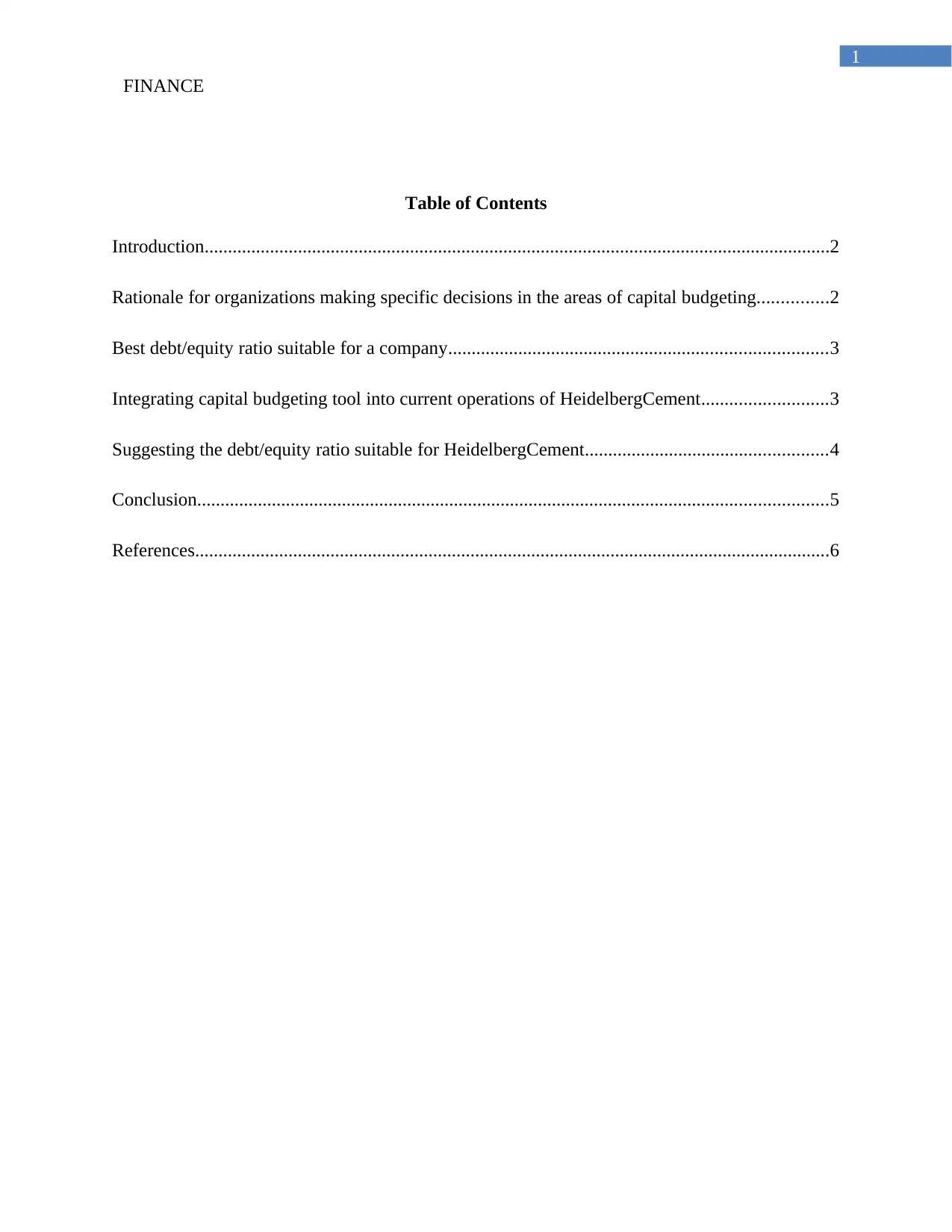
1
FINANCE
Table of Contents
Introduction......................................................................................................................................2
Rationale for organizations making specific decisions in the areas of capital budgeting...............2
Best debt/equity ratio suitable for a company.................................................................................3
Integrating capital budgeting tool into current operations of HeidelbergCement...........................3
Suggesting the debt/equity ratio suitable for HeidelbergCement....................................................4
Conclusion.......................................................................................................................................5
References........................................................................................................................................6
FINANCE
Table of Contents
Introduction......................................................................................................................................2
Rationale for organizations making specific decisions in the areas of capital budgeting...............2
Best debt/equity ratio suitable for a company.................................................................................3
Integrating capital budgeting tool into current operations of HeidelbergCement...........................3
Suggesting the debt/equity ratio suitable for HeidelbergCement....................................................4
Conclusion.......................................................................................................................................5
References........................................................................................................................................6
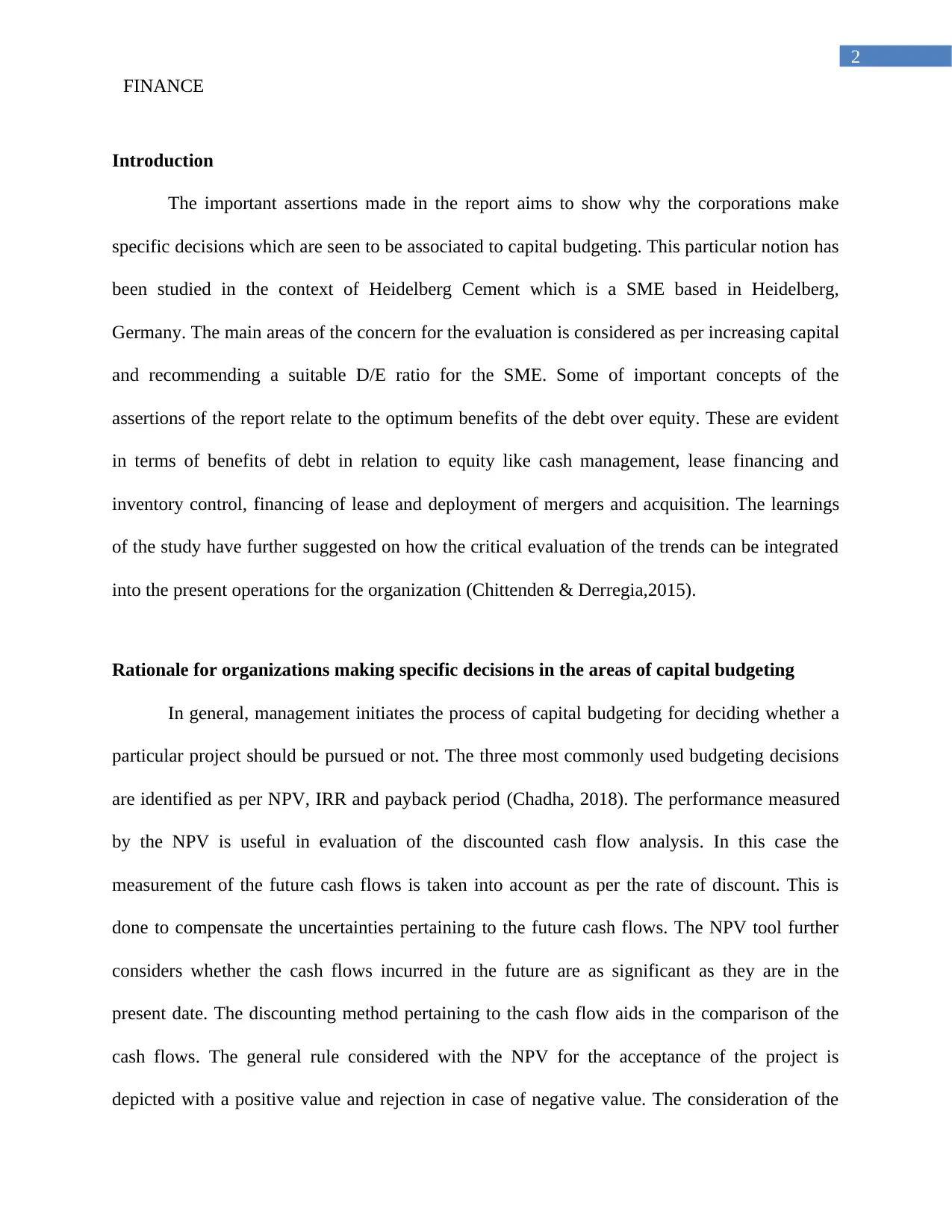
2
FINANCE
Introduction
The important assertions made in the report aims to show why the corporations make
specific decisions which are seen to be associated to capital budgeting. This particular notion has
been studied in the context of Heidelberg Cement which is a SME based in Heidelberg,
Germany. The main areas of the concern for the evaluation is considered as per increasing capital
and recommending a suitable D/E ratio for the SME. Some of important concepts of the
assertions of the report relate to the optimum benefits of the debt over equity. These are evident
in terms of benefits of debt in relation to equity like cash management, lease financing and
inventory control, financing of lease and deployment of mergers and acquisition. The learnings
of the study have further suggested on how the critical evaluation of the trends can be integrated
into the present operations for the organization (Chittenden & Derregia,2015).
Rationale for organizations making specific decisions in the areas of capital budgeting
In general, management initiates the process of capital budgeting for deciding whether a
particular project should be pursued or not. The three most commonly used budgeting decisions
are identified as per NPV, IRR and payback period (Chadha, 2018). The performance measured
by the NPV is useful in evaluation of the discounted cash flow analysis. In this case the
measurement of the future cash flows is taken into account as per the rate of discount. This is
done to compensate the uncertainties pertaining to the future cash flows. The NPV tool further
considers whether the cash flows incurred in the future are as significant as they are in the
present date. The discounting method pertaining to the cash flow aids in the comparison of the
cash flows. The general rule considered with the NPV for the acceptance of the project is
depicted with a positive value and rejection in case of negative value. The consideration of the
FINANCE
Introduction
The important assertions made in the report aims to show why the corporations make
specific decisions which are seen to be associated to capital budgeting. This particular notion has
been studied in the context of Heidelberg Cement which is a SME based in Heidelberg,
Germany. The main areas of the concern for the evaluation is considered as per increasing capital
and recommending a suitable D/E ratio for the SME. Some of important concepts of the
assertions of the report relate to the optimum benefits of the debt over equity. These are evident
in terms of benefits of debt in relation to equity like cash management, lease financing and
inventory control, financing of lease and deployment of mergers and acquisition. The learnings
of the study have further suggested on how the critical evaluation of the trends can be integrated
into the present operations for the organization (Chittenden & Derregia,2015).
Rationale for organizations making specific decisions in the areas of capital budgeting
In general, management initiates the process of capital budgeting for deciding whether a
particular project should be pursued or not. The three most commonly used budgeting decisions
are identified as per NPV, IRR and payback period (Chadha, 2018). The performance measured
by the NPV is useful in evaluation of the discounted cash flow analysis. In this case the
measurement of the future cash flows is taken into account as per the rate of discount. This is
done to compensate the uncertainties pertaining to the future cash flows. The NPV tool further
considers whether the cash flows incurred in the future are as significant as they are in the
present date. The discounting method pertaining to the cash flow aids in the comparison of the
cash flows. The general rule considered with the NPV for the acceptance of the project is
depicted with a positive value and rejection in case of negative value. The consideration of the
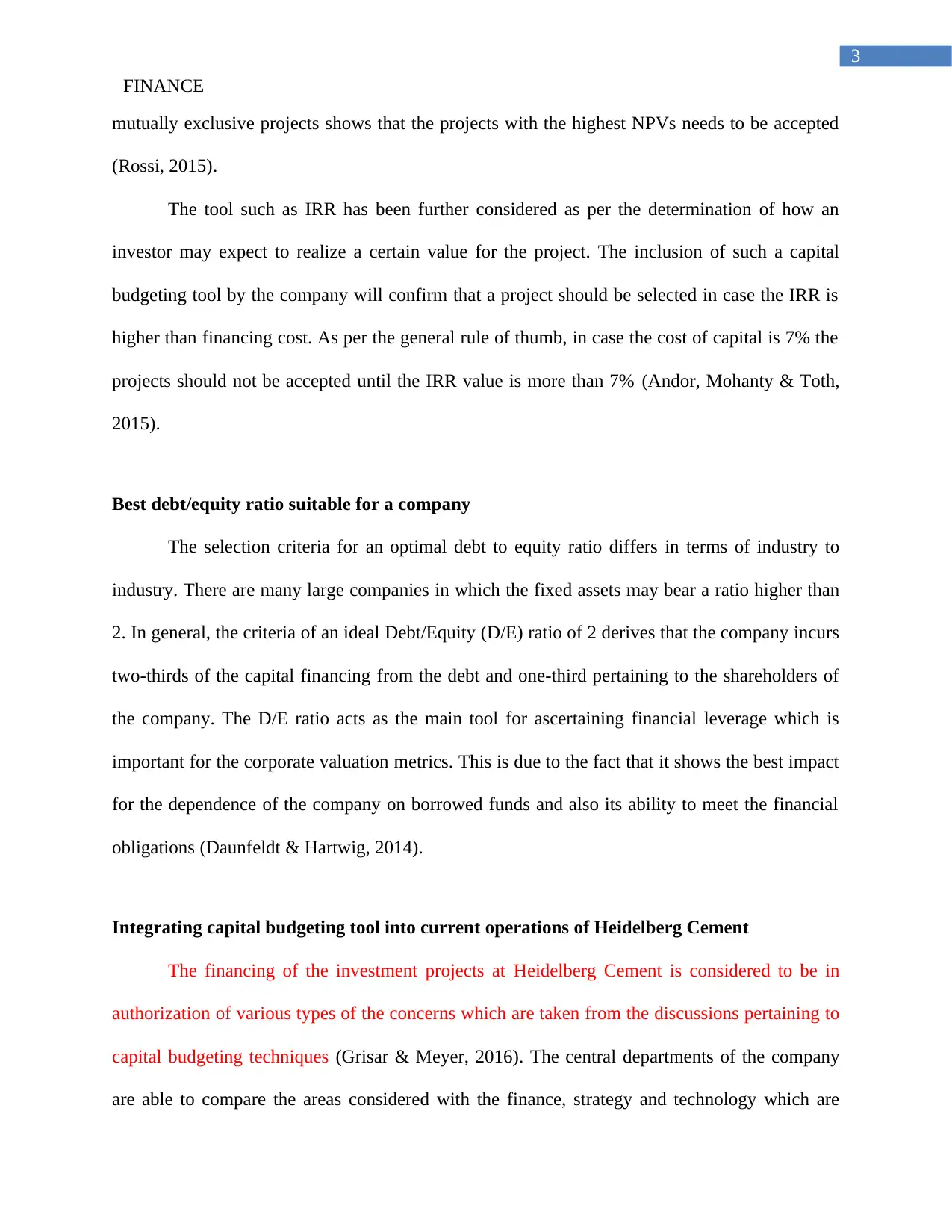
3
FINANCE
mutually exclusive projects shows that the projects with the highest NPVs needs to be accepted
(Rossi, 2015).
The tool such as IRR has been further considered as per the determination of how an
investor may expect to realize a certain value for the project. The inclusion of such a capital
budgeting tool by the company will confirm that a project should be selected in case the IRR is
higher than financing cost. As per the general rule of thumb, in case the cost of capital is 7% the
projects should not be accepted until the IRR value is more than 7% (Andor, Mohanty & Toth,
2015).
Best debt/equity ratio suitable for a company
The selection criteria for an optimal debt to equity ratio differs in terms of industry to
industry. There are many large companies in which the fixed assets may bear a ratio higher than
2. In general, the criteria of an ideal Debt/Equity (D/E) ratio of 2 derives that the company incurs
two-thirds of the capital financing from the debt and one-third pertaining to the shareholders of
the company. The D/E ratio acts as the main tool for ascertaining financial leverage which is
important for the corporate valuation metrics. This is due to the fact that it shows the best impact
for the dependence of the company on borrowed funds and also its ability to meet the financial
obligations (Daunfeldt & Hartwig, 2014).
Integrating capital budgeting tool into current operations of Heidelberg Cement
The financing of the investment projects at Heidelberg Cement is considered to be in
authorization of various types of the concerns which are taken from the discussions pertaining to
capital budgeting techniques (Grisar & Meyer, 2016). The central departments of the company
are able to compare the areas considered with the finance, strategy and technology which are
FINANCE
mutually exclusive projects shows that the projects with the highest NPVs needs to be accepted
(Rossi, 2015).
The tool such as IRR has been further considered as per the determination of how an
investor may expect to realize a certain value for the project. The inclusion of such a capital
budgeting tool by the company will confirm that a project should be selected in case the IRR is
higher than financing cost. As per the general rule of thumb, in case the cost of capital is 7% the
projects should not be accepted until the IRR value is more than 7% (Andor, Mohanty & Toth,
2015).
Best debt/equity ratio suitable for a company
The selection criteria for an optimal debt to equity ratio differs in terms of industry to
industry. There are many large companies in which the fixed assets may bear a ratio higher than
2. In general, the criteria of an ideal Debt/Equity (D/E) ratio of 2 derives that the company incurs
two-thirds of the capital financing from the debt and one-third pertaining to the shareholders of
the company. The D/E ratio acts as the main tool for ascertaining financial leverage which is
important for the corporate valuation metrics. This is due to the fact that it shows the best impact
for the dependence of the company on borrowed funds and also its ability to meet the financial
obligations (Daunfeldt & Hartwig, 2014).
Integrating capital budgeting tool into current operations of Heidelberg Cement
The financing of the investment projects at Heidelberg Cement is considered to be in
authorization of various types of the concerns which are taken from the discussions pertaining to
capital budgeting techniques (Grisar & Meyer, 2016). The central departments of the company
are able to compare the areas considered with the finance, strategy and technology which are
Secure Best Marks with AI Grader
Need help grading? Try our AI Grader for instant feedback on your assignments.
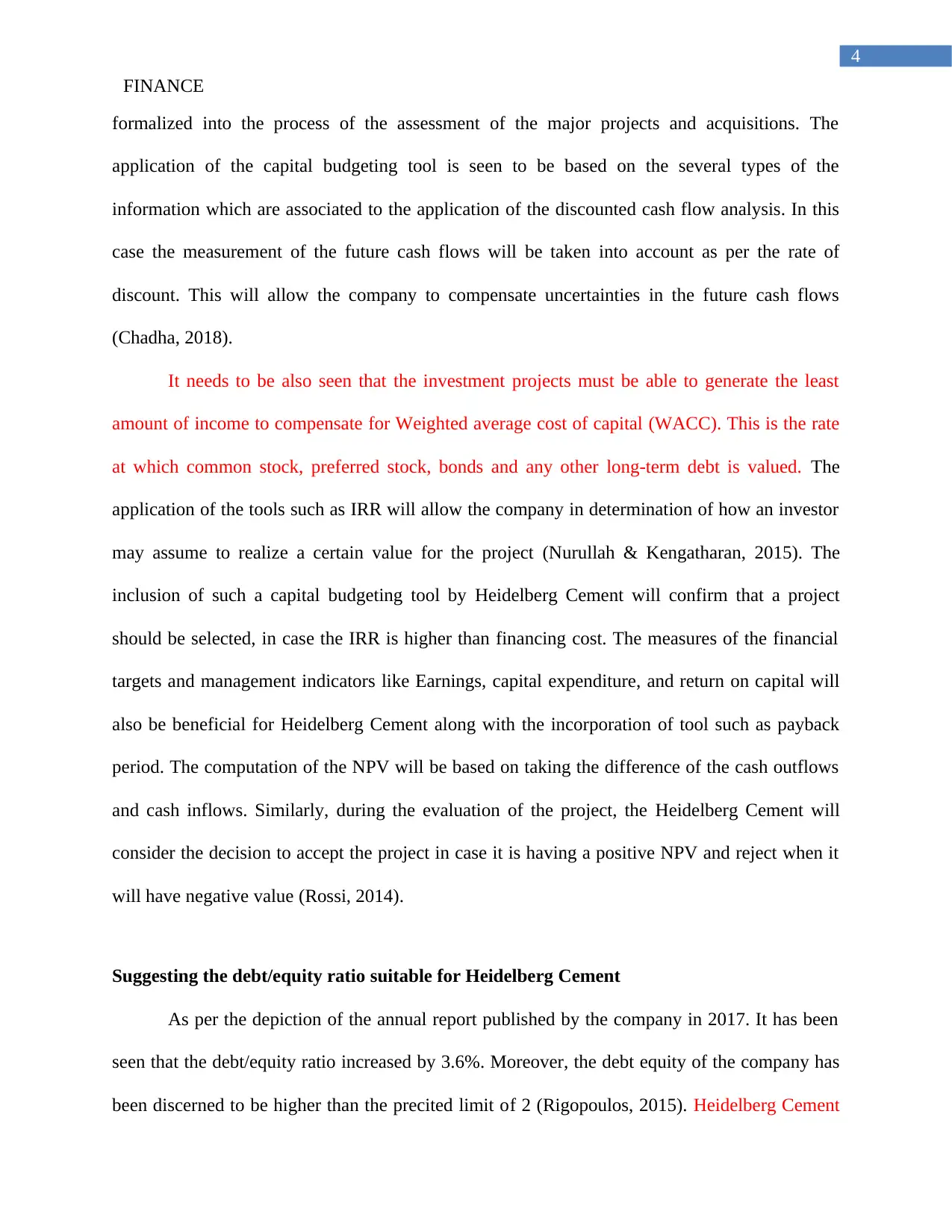
4
FINANCE
formalized into the process of the assessment of the major projects and acquisitions. The
application of the capital budgeting tool is seen to be based on the several types of the
information which are associated to the application of the discounted cash flow analysis. In this
case the measurement of the future cash flows will be taken into account as per the rate of
discount. This will allow the company to compensate uncertainties in the future cash flows
(Chadha, 2018).
It needs to be also seen that the investment projects must be able to generate the least
amount of income to compensate for Weighted average cost of capital (WACC). This is the rate
at which common stock, preferred stock, bonds and any other long-term debt is valued. The
application of the tools such as IRR will allow the company in determination of how an investor
may assume to realize a certain value for the project (Nurullah & Kengatharan, 2015). The
inclusion of such a capital budgeting tool by Heidelberg Cement will confirm that a project
should be selected, in case the IRR is higher than financing cost. The measures of the financial
targets and management indicators like Earnings, capital expenditure, and return on capital will
also be beneficial for Heidelberg Cement along with the incorporation of tool such as payback
period. The computation of the NPV will be based on taking the difference of the cash outflows
and cash inflows. Similarly, during the evaluation of the project, the Heidelberg Cement will
consider the decision to accept the project in case it is having a positive NPV and reject when it
will have negative value (Rossi, 2014).
Suggesting the debt/equity ratio suitable for Heidelberg Cement
As per the depiction of the annual report published by the company in 2017. It has been
seen that the debt/equity ratio increased by 3.6%. Moreover, the debt equity of the company has
been discerned to be higher than the precited limit of 2 (Rigopoulos, 2015). Heidelberg Cement
FINANCE
formalized into the process of the assessment of the major projects and acquisitions. The
application of the capital budgeting tool is seen to be based on the several types of the
information which are associated to the application of the discounted cash flow analysis. In this
case the measurement of the future cash flows will be taken into account as per the rate of
discount. This will allow the company to compensate uncertainties in the future cash flows
(Chadha, 2018).
It needs to be also seen that the investment projects must be able to generate the least
amount of income to compensate for Weighted average cost of capital (WACC). This is the rate
at which common stock, preferred stock, bonds and any other long-term debt is valued. The
application of the tools such as IRR will allow the company in determination of how an investor
may assume to realize a certain value for the project (Nurullah & Kengatharan, 2015). The
inclusion of such a capital budgeting tool by Heidelberg Cement will confirm that a project
should be selected, in case the IRR is higher than financing cost. The measures of the financial
targets and management indicators like Earnings, capital expenditure, and return on capital will
also be beneficial for Heidelberg Cement along with the incorporation of tool such as payback
period. The computation of the NPV will be based on taking the difference of the cash outflows
and cash inflows. Similarly, during the evaluation of the project, the Heidelberg Cement will
consider the decision to accept the project in case it is having a positive NPV and reject when it
will have negative value (Rossi, 2014).
Suggesting the debt/equity ratio suitable for Heidelberg Cement
As per the depiction of the annual report published by the company in 2017. It has been
seen that the debt/equity ratio increased by 3.6%. Moreover, the debt equity of the company has
been discerned to be higher than the precited limit of 2 (Rigopoulos, 2015). Heidelberg Cement
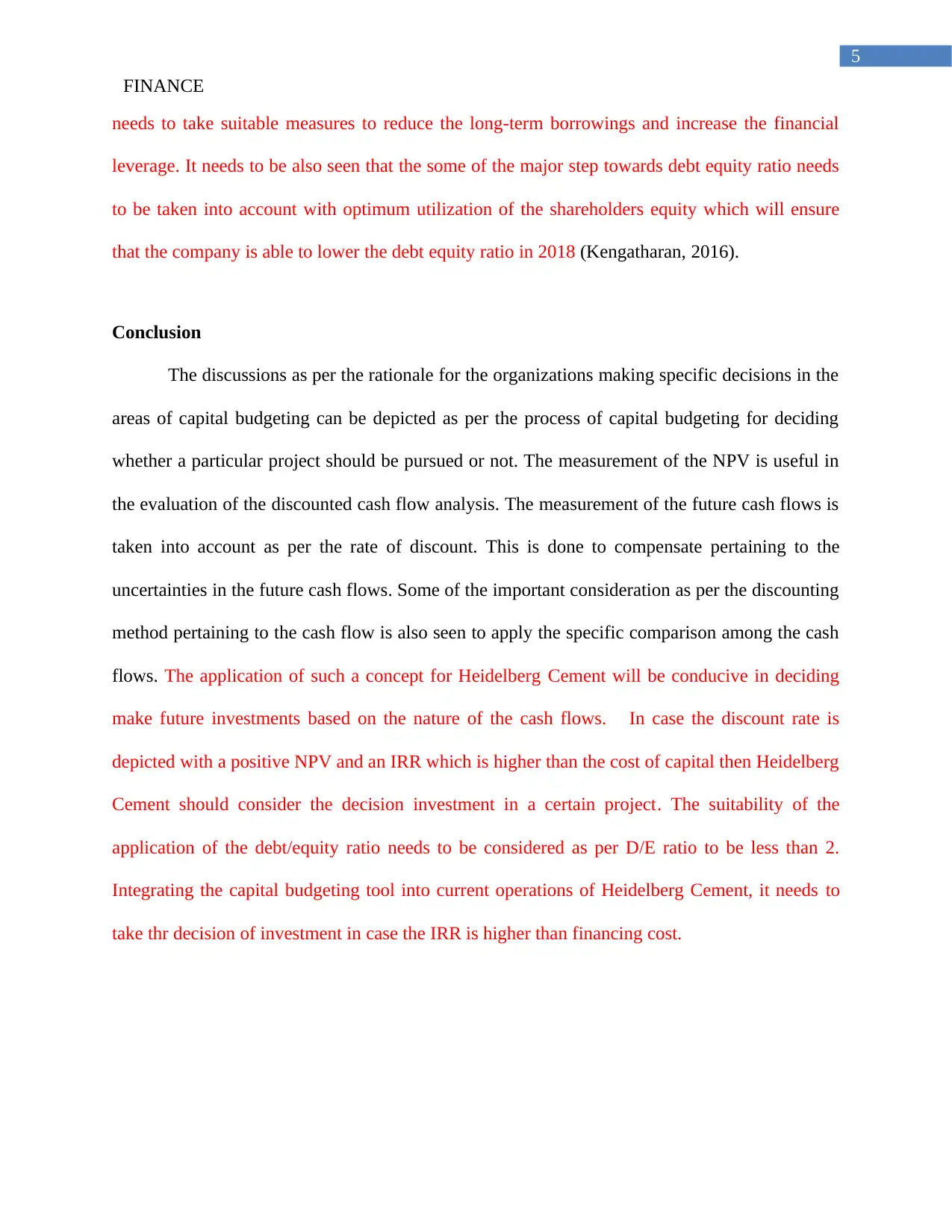
5
FINANCE
needs to take suitable measures to reduce the long-term borrowings and increase the financial
leverage. It needs to be also seen that the some of the major step towards debt equity ratio needs
to be taken into account with optimum utilization of the shareholders equity which will ensure
that the company is able to lower the debt equity ratio in 2018 (Kengatharan, 2016).
Conclusion
The discussions as per the rationale for the organizations making specific decisions in the
areas of capital budgeting can be depicted as per the process of capital budgeting for deciding
whether a particular project should be pursued or not. The measurement of the NPV is useful in
the evaluation of the discounted cash flow analysis. The measurement of the future cash flows is
taken into account as per the rate of discount. This is done to compensate pertaining to the
uncertainties in the future cash flows. Some of the important consideration as per the discounting
method pertaining to the cash flow is also seen to apply the specific comparison among the cash
flows. The application of such a concept for Heidelberg Cement will be conducive in deciding
make future investments based on the nature of the cash flows. In case the discount rate is
depicted with a positive NPV and an IRR which is higher than the cost of capital then Heidelberg
Cement should consider the decision investment in a certain project. The suitability of the
application of the debt/equity ratio needs to be considered as per D/E ratio to be less than 2.
Integrating the capital budgeting tool into current operations of Heidelberg Cement, it needs to
take thr decision of investment in case the IRR is higher than financing cost.
FINANCE
needs to take suitable measures to reduce the long-term borrowings and increase the financial
leverage. It needs to be also seen that the some of the major step towards debt equity ratio needs
to be taken into account with optimum utilization of the shareholders equity which will ensure
that the company is able to lower the debt equity ratio in 2018 (Kengatharan, 2016).
Conclusion
The discussions as per the rationale for the organizations making specific decisions in the
areas of capital budgeting can be depicted as per the process of capital budgeting for deciding
whether a particular project should be pursued or not. The measurement of the NPV is useful in
the evaluation of the discounted cash flow analysis. The measurement of the future cash flows is
taken into account as per the rate of discount. This is done to compensate pertaining to the
uncertainties in the future cash flows. Some of the important consideration as per the discounting
method pertaining to the cash flow is also seen to apply the specific comparison among the cash
flows. The application of such a concept for Heidelberg Cement will be conducive in deciding
make future investments based on the nature of the cash flows. In case the discount rate is
depicted with a positive NPV and an IRR which is higher than the cost of capital then Heidelberg
Cement should consider the decision investment in a certain project. The suitability of the
application of the debt/equity ratio needs to be considered as per D/E ratio to be less than 2.
Integrating the capital budgeting tool into current operations of Heidelberg Cement, it needs to
take thr decision of investment in case the IRR is higher than financing cost.
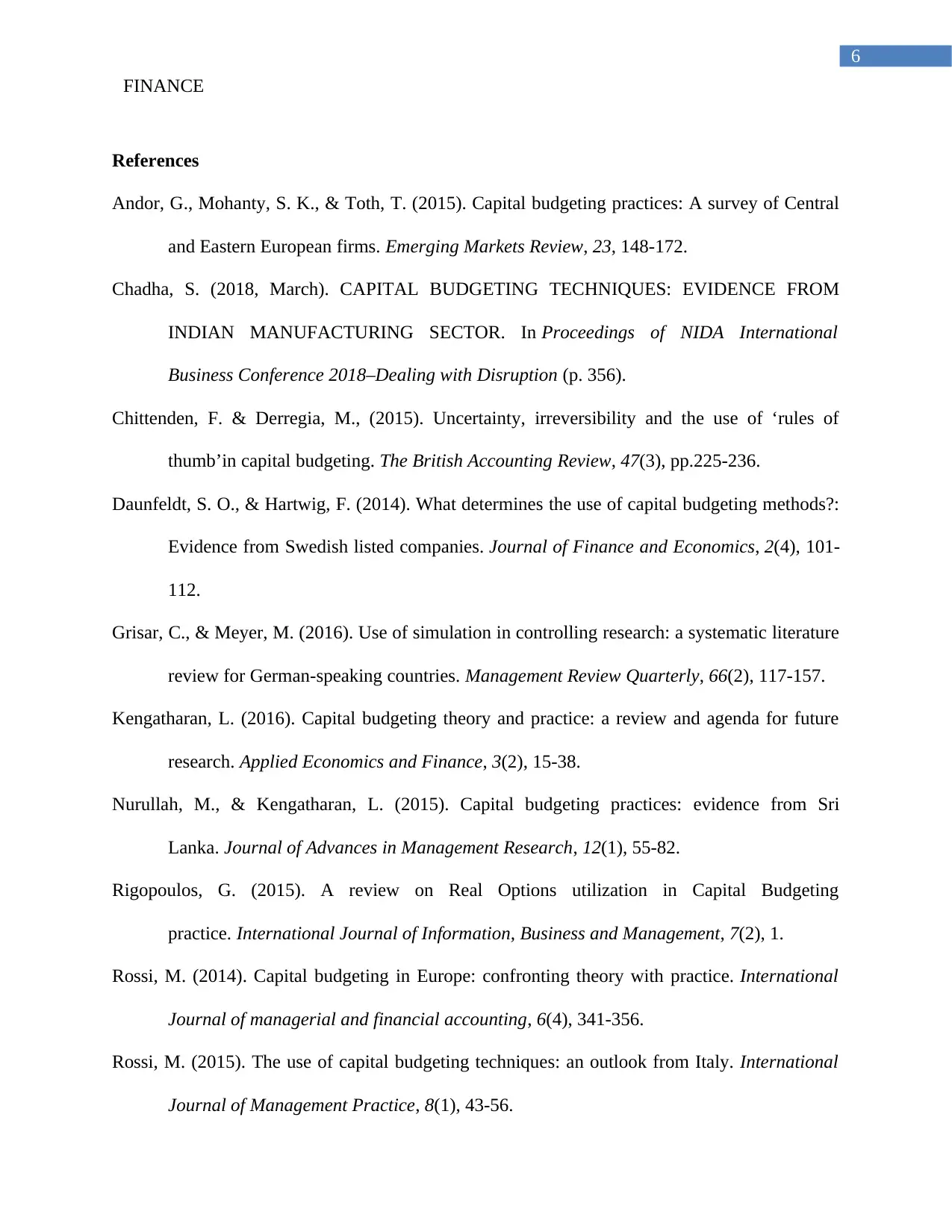
6
FINANCE
References
Andor, G., Mohanty, S. K., & Toth, T. (2015). Capital budgeting practices: A survey of Central
and Eastern European firms. Emerging Markets Review, 23, 148-172.
Chadha, S. (2018, March). CAPITAL BUDGETING TECHNIQUES: EVIDENCE FROM
INDIAN MANUFACTURING SECTOR. In Proceedings of NIDA International
Business Conference 2018–Dealing with Disruption (p. 356).
Chittenden, F. & Derregia, M., (2015). Uncertainty, irreversibility and the use of ‘rules of
thumb’in capital budgeting. The British Accounting Review, 47(3), pp.225-236.
Daunfeldt, S. O., & Hartwig, F. (2014). What determines the use of capital budgeting methods?:
Evidence from Swedish listed companies. Journal of Finance and Economics, 2(4), 101-
112.
Grisar, C., & Meyer, M. (2016). Use of simulation in controlling research: a systematic literature
review for German-speaking countries. Management Review Quarterly, 66(2), 117-157.
Kengatharan, L. (2016). Capital budgeting theory and practice: a review and agenda for future
research. Applied Economics and Finance, 3(2), 15-38.
Nurullah, M., & Kengatharan, L. (2015). Capital budgeting practices: evidence from Sri
Lanka. Journal of Advances in Management Research, 12(1), 55-82.
Rigopoulos, G. (2015). A review on Real Options utilization in Capital Budgeting
practice. International Journal of Information, Business and Management, 7(2), 1.
Rossi, M. (2014). Capital budgeting in Europe: confronting theory with practice. International
Journal of managerial and financial accounting, 6(4), 341-356.
Rossi, M. (2015). The use of capital budgeting techniques: an outlook from Italy. International
Journal of Management Practice, 8(1), 43-56.
FINANCE
References
Andor, G., Mohanty, S. K., & Toth, T. (2015). Capital budgeting practices: A survey of Central
and Eastern European firms. Emerging Markets Review, 23, 148-172.
Chadha, S. (2018, March). CAPITAL BUDGETING TECHNIQUES: EVIDENCE FROM
INDIAN MANUFACTURING SECTOR. In Proceedings of NIDA International
Business Conference 2018–Dealing with Disruption (p. 356).
Chittenden, F. & Derregia, M., (2015). Uncertainty, irreversibility and the use of ‘rules of
thumb’in capital budgeting. The British Accounting Review, 47(3), pp.225-236.
Daunfeldt, S. O., & Hartwig, F. (2014). What determines the use of capital budgeting methods?:
Evidence from Swedish listed companies. Journal of Finance and Economics, 2(4), 101-
112.
Grisar, C., & Meyer, M. (2016). Use of simulation in controlling research: a systematic literature
review for German-speaking countries. Management Review Quarterly, 66(2), 117-157.
Kengatharan, L. (2016). Capital budgeting theory and practice: a review and agenda for future
research. Applied Economics and Finance, 3(2), 15-38.
Nurullah, M., & Kengatharan, L. (2015). Capital budgeting practices: evidence from Sri
Lanka. Journal of Advances in Management Research, 12(1), 55-82.
Rigopoulos, G. (2015). A review on Real Options utilization in Capital Budgeting
practice. International Journal of Information, Business and Management, 7(2), 1.
Rossi, M. (2014). Capital budgeting in Europe: confronting theory with practice. International
Journal of managerial and financial accounting, 6(4), 341-356.
Rossi, M. (2015). The use of capital budgeting techniques: an outlook from Italy. International
Journal of Management Practice, 8(1), 43-56.
1 out of 7
Related Documents
Your All-in-One AI-Powered Toolkit for Academic Success.
+13062052269
info@desklib.com
Available 24*7 on WhatsApp / Email
![[object Object]](/_next/static/media/star-bottom.7253800d.svg)
Unlock your academic potential
© 2024 | Zucol Services PVT LTD | All rights reserved.





